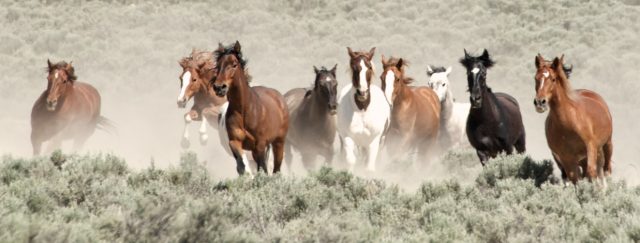Type the name of the breed you're looking for below
[wpdreams_ajaxsearchlite] Don't see the breed your're looking for? Click here and let us know!
American Mustang horse
| Country Of Origin | United States |
| History and Background | When people think of the Wild West, they often conjure up ideas of cowboys, Indians, saloons, and poker. But ask someone about horses in the Wild West and the American Mustang will probably come to mind. Originally of Spanish decent, this horse breed was formally established in North America and took on the role of the quintessential muscular, athletic horse for United States riders. The English word "mustang" comes from the Mexican Spanish term mestengo, derived from the Spanish word mesteño, meaning "stray" or "feral." As its name indicates, the American Mustang roamed North America freely. From a mixed bloodline of Barb, Arabian and Andalusian, the breed was brought over by Spanish Conquistadors, beginning with Columbus during his second voyage in 1493. Native Americans quickly adopted the Mustang as a mode of transportation, using them in battles, for hunting, and as a bartering item. During the westward migration of the 1800s, Americans took to these horses and attempted to improve the breed. It was common practice for Western ranchers to release their horses to forage for themselves and then upon recapturing, take in the Mustangs that had joined the horse group. In 1962, a registry for the American Mustang breed was established in San Diego, California. The American Mustang Association (AMA) had a very simple purpose: to collect and record the American Mustang pedigree. Currently, to be registered with the AMA, a horse must conform to the association's physical proportions and size standards; whether or not the bloodline or ancestry of the horse is pure is not that important. Through this selection (and inclusion) process, the AMA hopes to preserve the original characteristics of the ancient Mustang. |
| Use Today | Carriage horse, Cow horse, Trail horse, General riding, Feral |
| Height | 13 to 16 hands (52 to 64 inches, 132 to 163 cm) |
| Colour | Any colours and patterns |
| Characteristics | As Barb descendants, a true mustang should have 17 ribs and 5 lumbar vertebrae. The American Mustang’s carriage is majestic and symmetric, every body part proportional to the rest. Its long, highly crested neck blends smoothly with its sloping shoulders. And its head, which narrows down to a fine muzzle, gives the Mustang a rather proud look. The American Mustang is muscular, but not overly so. This is especially noticeable in its long, defined legs and straight back. Compact, rounded hooves and a low-set tail are also standard for this breed. Overall, the American Mustang shows nobility and refinement in its form and lines, making it a great horse for all occasions. |
| Personality and Temperament | Initially, the American Mustang can be difficult and is known to have a noticeable independent streak, especially when it has been taken from the wild. However, once properly trained, this intelligent horse is among the best riding horses in the world. |



